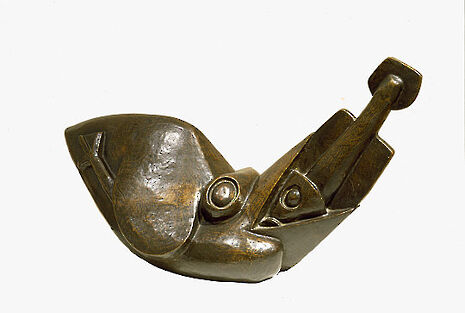Exhibition: Henri Gaudier-Brzeska – Vorticist!
Aliya Ram heads to Kettle’s Yard to find out about renewed interest in the artist’s work

“A vorti-what?”
“A Vorticist. He was friends with Ezra Pound and Eliot and things.”
“Oh, right.”
Vorticism, perhaps the most avant-garde and cohesive art movement to emerge on the British Isles, was so ephemeral that history had more or less forgotten about it. Still, much like fruit shoots or fruit winders (which changed an entire generation’s understanding about the relationship between fruit and candy) it should not have been forgotten about. What a relief, then, that last year brought with it the rediscovery of Vorticism! Sparked by the Tate’s exhibition, ‘The Vorticists: Manifesto for a modern world’, there has been an explosion of critical interest in Vorticism – an explosion that has, of course, made its winding way to Cambridge.
Jim Ede (original owner of Kettle’s Yard)was an avid collector of Henri Gaudier-Brzeska – one of the group of artists to form the Rebel Art Centre in 1914. Gaudier-Brzeska, who was primarily a sculptor although many of his most iconic works are in China ink, helped Wyndham Lewis and Jacob Epstein (among others) to found the Centre in opposition to Roger Fry’s autocratic regime at the Omega workshops in London. The group would be baptised ‘the Vorticists’ by Ezra Pound, a close friend and collaborator.
Gaudier-Brzeska’s ink sketch of Ezra Pound is one of many of his works that have been taken out of Kettle’s Yard’s reserve collection and displayed on location accompanied by contextual materials from the archive. Among the others is his series of self-portraits, and a bronze cast of The Dancer, famous for its perfect embodiment of Rodin’s principle that movement should be depicted in sculpture by capturing the instant when one stationary position transforms into another.
The gallery pays appropriate tribute to Gaudier-Brzeska’s consuming dedication to the Vorticists, symbolised by his Toy, which Ezra Pound declared the finest of his experiments, and used as a totem to fiddle with whilst trying to think. Gaudier-Brzeska’s investment in the Vorticist fascination with the relationship between animals and machines is also represented in the exhibition, in the sharp angles and aggressive geometrisation of his Bird Swallowing a Fish. The sculpture sits in the middle of the second room, hanging in its moment of suspended animation for a viewer to consider as they walk around – will the fish will choke the bird? Or the bird swallow the fish?
Arranged neatly in the small rooms, Gaudier-Brzeska’s brilliant work could not look more at home at Kettle’s Yard. Which makes sense, because they are at home – just moments away from the bedroom in which Ede lovingly sheltered them.
 Features / Should I stay or should I go? Cambridge students and alumni reflect on how their memories stay with them15 December 2025
Features / Should I stay or should I go? Cambridge students and alumni reflect on how their memories stay with them15 December 2025 News / Cambridge study finds students learn better with notes than AI13 December 2025
News / Cambridge study finds students learn better with notes than AI13 December 2025 News / Dons warn PM about Vet School closure16 December 2025
News / Dons warn PM about Vet School closure16 December 2025 Comment / The magic of an eight-week term15 December 2025
Comment / The magic of an eight-week term15 December 2025 News / News In Brief: Michaelmas marriages, monogamous mammals, and messaging manipulation15 December 2025
News / News In Brief: Michaelmas marriages, monogamous mammals, and messaging manipulation15 December 2025









